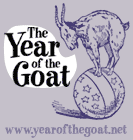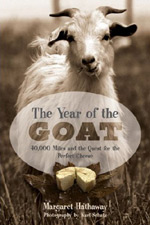Inside a series of linked buildings, huge burlap sacks of white wool and mohair, and the rainbow hues of alpaca fiber, are delivered by area producers, weighed, and stacked in rows that nearly touch the thirty foot ceiling. In the heyday of mohair production, before the subsidy was phased out by the Clinton Administration, the bags would be stacked so thickly that a person couldn't walk easily through the warehouse. Despite the reduced production, there are still thousands of sacks in storage, but the volume is a fraction of what it once was.
As we spoke with Seco Mayfield, the warehouse manager, several men reorganized the sacks, filling in the darker corners of the room as they opened up the center. Seco gestured to a wooden cutout on the wall of two foxes holding cocktails while leaning rakishly against a crest that read "Fling Ding," and explained that they were getting ready for the annual Fling Ding dance that has taken place in the warehouse since the Second World War. The event is huge, with thousands of attendees, and the previous years' bands have included Glen Miller and Hank Williams. It was to take place next week, and in the following days, the mohair would be hidden and the warehouse transformed with dropped ceilings and paneled walls.
As the men continued their work, Seco led us over a raised walkway to another building (soon to be the Fling Ding's bar) to show us the sorting areas and give us a brief lesson in fiber quality. Like any fiber, mohair is graded before sale, and the hair he showed us had been sorted into rolling bins. Seco let us feel the fiber in each, explaining the grade. Some, which was coarse or stained, was good only for making carpets. Another batch was softer, but still not fine enough to be worn directly against the skin. The final bin, containing the first shearings of fall kids, was as soft as a cloud. Interestingly, several different grades of fiber can come from the same animal, which complicates the sorting process, but makes it especially important, since it ensures that both the producer and the processor know exactly what each bag contains.
From the warehouse, mohair is sold to processors who turn it into roving, or top, as it's called industrially. It is sold by the individual producers, whose names appear on the bags. Individual ranchers maintain their identity, and become known for the thoroughness of their sorting and the fineness of their mohair. Though the warehouse facilitates all sales, it doesn't buy or sell fiber in its own name, but rather stores it and connects the producers with the market. Some choose not to sell, and their bags remain in the warehouse for years; others do a brisk business with regular buyers.
 |
| Seco Mayfield - enlarge photo |
Seco said before we left that they were planning to do about 800 animals, a third of his angora herd, and when we arrived the following afternoon, the shearing was underway. After Chris, Seco's herd manager, had rounded them up on horseback, the goats were led in batches of about fifty animals into the shearing pen, where eight men knelt with clippers. It took each man about five minutes to complete a goat, shaving the hair so quickly that it seemed to come off the animals in fluffy, wide stripes. Because of the cold, the shearers left a long cape down the goats' spines for warmth.
The shearers spoke Spanish to one another, shouting over the din of clippers, and helping each other corral the goats. They were paid by the animal, and in their haste some became aggressive and careless in their speed, nicking the animals, leaving shallow but bloody gashes on their skin, and on one occasion breaking a horn, at which point the boss, a man Seco refered to as El Capitan, would come over and reprimand them. Because of the volume of goats, ranchers rarely do their own shearing, relying instead upon companies like El Capitan's, who travel the area with their equipment, working for several days at various ranches. Seco was planning to hire them again in the next few weeks to shear another seven hundred goats, but then to wait a month before finishing the last thousand.
Driving down the dusty farm road as we left Seco's ranch, Karl and I talked about the shear numbers of goats we'd seen, and the incredible volume of their hair. Seco ranches twelve thousand acres, on which he runs three thousand goats (he has five hundred which are not angoras). The human population of Sonora is smaller than the size of his herd. Again we were struck by the industrial scale of Texas' goat culture; more goats were shorn in one batch of Seco's angoras than the entire herds of some farmers we'd visited in other states. There's no judgment to this statement, it's neither good nor bad. It's just true that everything is bigger in Texas. —MMH




